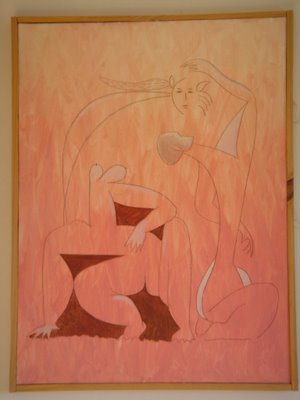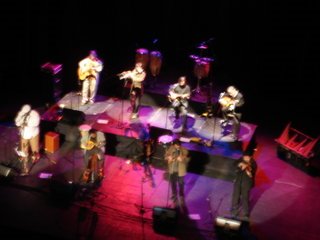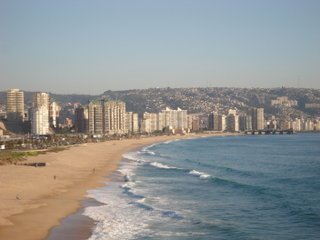Saturday, my buddy David and I decided to climb "Cerro la Campana" which lies inland from Valparaíso. The mountain (although "cerro" is the word for hill, "Cerro la Campana" is closer to a mountain than a hill; the summit is about 1,900 meters or 6,000 feet) sits in Parque Nacional la Campana. Darwin climbed the mountain in 1883 (I think) on his journey around the world. The park itself was created in 1967 and is a UNESCO biosphere reserve because of it's biological diversity. Most notably, it is home to the Chilean palm, a fascinating species of tree that lives between 700-1000 years, bears edible fruit, and grows at latitudes where it is not typical to find palm trees. Anyway, smack dab in the middle of this park is a large hill, and from the top it is possible to see the ocean on one side, and the Andes on the other. Very cool. We wanted to climb it.
Saturday I woke up at 8:00, threw some stuff in my backpack, grabbed my boots, made a lunch, and headed to Chorrillos to meet up with David. Needless to say I was a little late for our 8:15 meeting time, but I've really gotten used to this Chilean time schedule. To get to La Campana, first one must take a micro to Limache, then take a micro to Olmué, then take a micro from Olmué to Cerro la Campana. Three micros, 2 hours, and several discussions with micro drivers later, we found ourselves at the entrance to the park. (It would be very difficult to get around in this country if I couldn't ask for directions--one lady actually drew us a map of where we needed to go.) We walked up to the tollbooth at the entrance, paid our 150o pesos each, and were given directions and a map. The whole affair was very official. We both had to give our full names, nationality, cell phone numbers, address, etc. They also told us that we had arrived too late in the day to climb to the summit. Instead, we could only hike to the old coal mine (about halfway) and that our turn-around time was 2:00 pm. They also said that if we weren't back by 5:30 they would call our cellphones to check in. Good grief! I found the situation quite amusing, actually. I mean, this country has open manholes 20 feet deep in the middle of the sidewalk. It seems contradictory that the safety procedures on a simple hike are so rigorous. In contrast, an uncovered manhole in the states would probably cause numerous lawsuits, but if you felt like walking into the woods woefully unprepared nobody would stop you.
The trail is seven kilometres long, and according to the time schedule we were given it requires 4.5 hours up and 3 hours down (to and from the summit....we had no intention whatsoever of stopping at the mine). I don't know what the elevation gain is, but it is substantial. From start to finish the trail is a very steep grade, and it was suprisingly difficult to climb. After 45 minutes of hiking we had broken through the cloud cover into the bright sunlight (and heat). The hike up was relatively uneventful. We reached the mine in just under two hours, and stopped for a quick bite to eat, then pushed on. By this point, it became clear that my sedentary lifestyle was not conducive to climbing mountains with ease. My legs simply did not want to function properly, and it was sheer stubborness that finally got me to the top. The second part of the hike, above the mine, was even steeper (2 kilometers in 2 hours) and the trail was frequently loose rock and scree. We stopped frequently to rest and drink, and finally made the summit at three o'clock.
On a clear day, I have no trouble believing that the view from the summit is beautiful. Even with clouds the view Saturday was worth the hike. However, I also got to see firsthand the smog cloud that sits over the third most polluted city in the world (I believe Santiago holds this post, although someone might want to fact-check that). It was really gross. It's bad enough to be visible in the photos I took. Sure, we could see the Andes, but they looked hazy and far away. In the other direction all we could see were clouds (and smog there as well). Also, the rocks all over the summit were absolutely plastered with graffiti. Side note: that stupid Abastible truck is driving up the street right behind me playing "Happy Birthday" and "It's a Small World" End side note. The graffiti was really hideous, and a good reminder of why it is important to practive "Leave no Trace." We hung out on the summit for about 15 minutes, and headed down.
The walk down was sketchy. We got lost once coming down a boulder field, and were constantly sending rocks tumbling down the mountain. Even once we found the trail again, it was no better. We had to take turns walking to avoid getting hit by rocks turned loose by the other person. One would walk ahead and then turn and watch as the other descended. We both fell a couple times too, but eventually we made it safely to the mine. Undoubtedly our clumsiness was related to our fatigue...had we been in better shape things probably would have gone a little more smoothly.
On the way down we stopped at the mine. According to the locals, the mine was in it's prime during the nineteenth century, and the mountain is so riddled with mineshafts that it is possible to walk in one side of the mountain and come out the other. Obviously we had no intention of doing that, but we did want to check it out a little bit. I had brought my headlamp, so we grabbed our stuff and ventured into the mineshaft. The shaft went back about 100 feet and then branched three ways. Two were dead ends because they had collapsed, and the other kept going as far as I could see. We didn't follow it very far...the floor of the tunnel was very wet and neither of us had a helmet, but we snapped some photos and continued on our way. My photos didn't turn out very well, so I didn't post them in this blog entry, but hopefully David's turned out better. I'll try to get them to post later.
On the way up, some locals had told us about tarantula-sized spiders that live in the park. These "Arañas Pollitos" are not poisonous, and they don't usually bite. However, they also told us that they saw one inside the mine shaft once. I'm very mildly arachnaphobic, and one reason I didn't want to spend too much time in the mine was because I was a little nervous that one of these huge arachnids was going to fall on my head. Oh, did I mention they can jump up to a foot? Augh! Anyway, we continued our hike down, and about 30 minutes after leaving the mine I damn near stepped on one of those bloody arañas. Scared the bejeebers out of me. After the initial shock, I whipped out my camera and leaned in to take a photo. When I was about a foot from the spider, David says "look out man, these things can jump!" and scared the beejebers out of me again. Funny thing is we didn't know at the time that they actually could jump; he was just joking around. Anyway, we took some more photos and kept walking. The rest of the hike was uneventful, and we got home by about 8 in the evening.
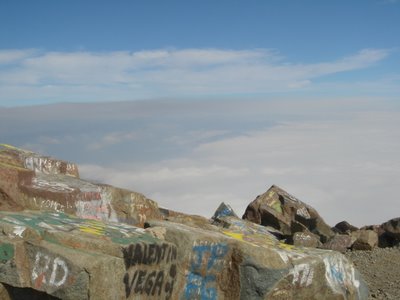
Graffiti, and smog. Lovely.
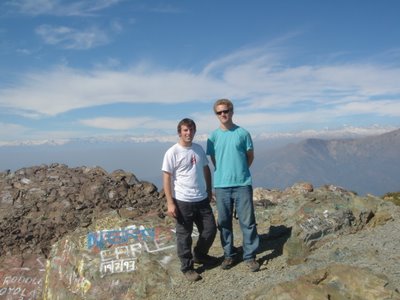
David and I on the summit, with the Andes (and smog) in the background.
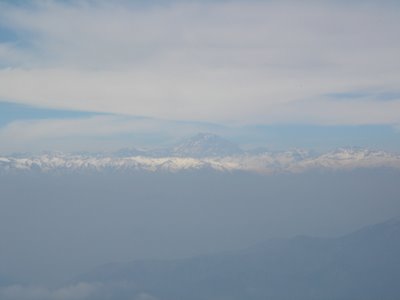
The Andes (and smog). I'm not sure what the peak in the middle is, but it absolutely towers over the rest of the mountain range. The photo, as usual, doesn't quite capture the full effect. I know there are peaks in the Andes that reach 22,000 feet, and that may well be one.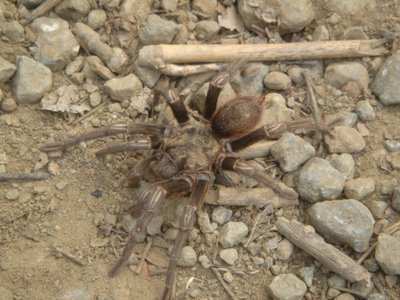 Araña Pollito.
Araña Pollito.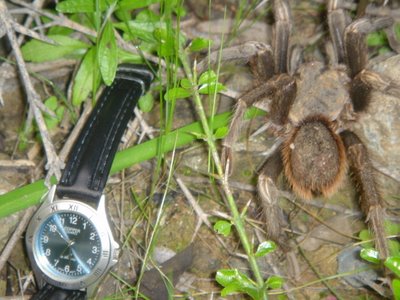 Araña Pollito with a scale for comparison. It really freaked me out to put the watch so close to the spider, so I hope you folks at home appreciate this pic.
Araña Pollito with a scale for comparison. It really freaked me out to put the watch so close to the spider, so I hope you folks at home appreciate this pic.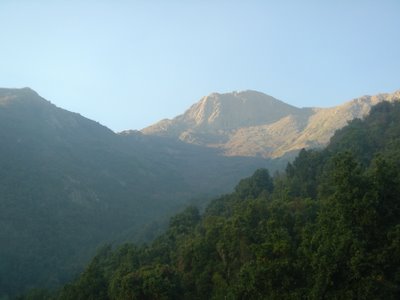
Cerro la Campana, from the trail on the way down. By the way, campana means "bell" in spanish.
ya me voy,
Andrius
 Welcome to the Market. This building sits right next to the Casa Central, and just across the street from the ISA office. It has been around for more than a century, and many of the employees are 2nd and 3rd generation. For a class project we had to interview someone that worked at the market. My partner and I ended up talking to the president, a very nice gentleman about 65 years old. I now know more about the market than I ever wanted to.
Welcome to the Market. This building sits right next to the Casa Central, and just across the street from the ISA office. It has been around for more than a century, and many of the employees are 2nd and 3rd generation. For a class project we had to interview someone that worked at the market. My partner and I ended up talking to the president, a very nice gentleman about 65 years old. I now know more about the market than I ever wanted to.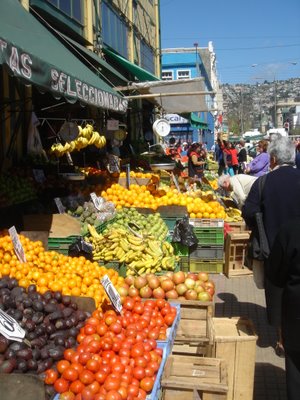


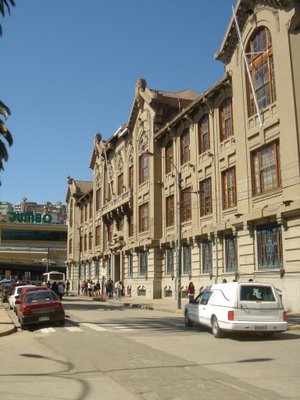
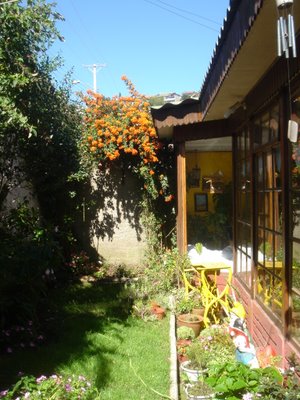
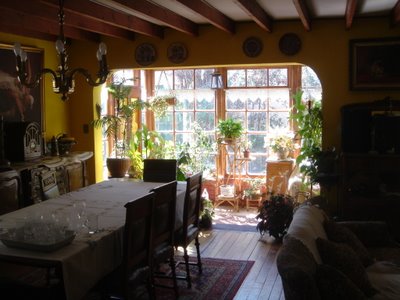 The dining room. I took this photo from the door that leads to the kitchen. To the right of the photo this room turns into a living room with couches and chairs. Out the window is the front yard.
The dining room. I took this photo from the door that leads to the kitchen. To the right of the photo this room turns into a living room with couches and chairs. Out the window is the front yard.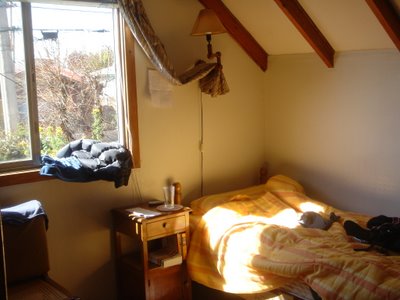
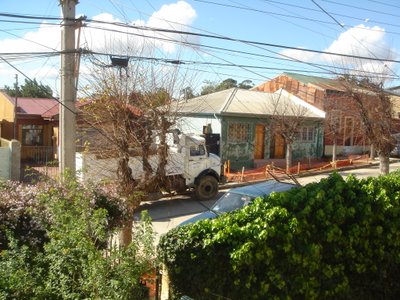 The view out my window. I can actually see the ocean in the other direction, but this picture is more representative.
The view out my window. I can actually see the ocean in the other direction, but this picture is more representative.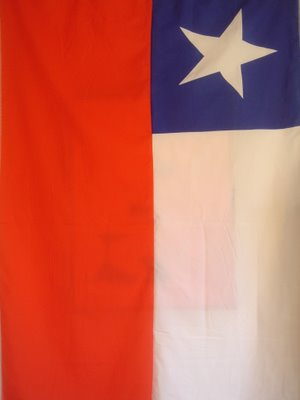 The Chilean flag. I put this up after the soccer game, and not only is it cool to have a Chilean flag in my room, I also don't have to look at the painting behind it. (See next photo.)
The Chilean flag. I put this up after the soccer game, and not only is it cool to have a Chilean flag in my room, I also don't have to look at the painting behind it. (See next photo.)